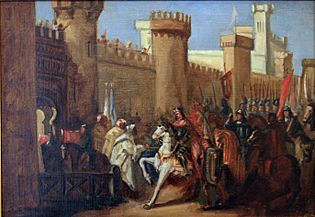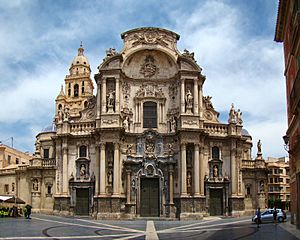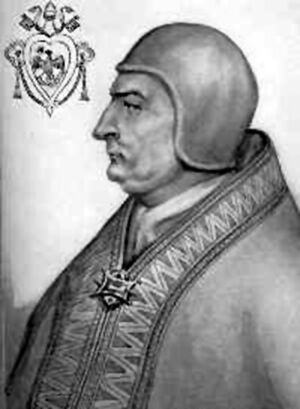Conquest of Murcia (1265–66) facts for kids
Quick facts for kids Conquest of Murcia |
|||||||||
|---|---|---|---|---|---|---|---|---|---|
| Part of the Mudéjar revolt of 1264–1266 | |||||||||
 James I of Aragon entering the city of Murcia after the surrender of its inhabitants, February 1266. |
|||||||||
|
|||||||||
| Belligerents | |||||||||
| Taifa of Murcia Supported by: |
|||||||||
| Commanders and leaders | |||||||||
| Al-Wathiq of Murcia |
|||||||||
The Conquest of Murcia was a military event that happened in 1265–1266. During this time, King James I of Aragon helped his ally, King Alfonso X of Castile, to take control of the Muslim-ruled area called the Taifa of Murcia.
Before this, Murcia was a semi-independent state that was loyal to Castile. However, Murcia decided to break away during the Mudéjar revolt of 1264–1266. Aragon joined the fight to help Castile after Queen Violant of Aragon, who was James I's daughter, asked her father for help.
After some discussions with his nobles, James I led his army from Valencia in late October 1265. His troops quickly captured several towns in Murcia. They also defeated a group of soldiers sent by the Emirate of Granada to help Murcia. The main siege of the city of Murcia began in January 1266. The city surrendered on January 31, and King James I entered on February 3.
After the conquest, Murcia was given back to Castile. It lost its independence and became a direct part of Castile. Many of its Muslim residents were moved to special areas, and Christian settlers were brought in to live in the region.
Contents
Why the Conflict Started: Murcia's Rebellion
In the early 1200s, the Christian kingdoms of Castile and Aragon conquered many Muslim states in southern Spain. Murcia, an important city in the southeast, surrendered to Prince Alfonso (who later became Alfonso X of Castile) on April 2, 1243.
After this, the Taifa of Murcia became a semi-independent state under Castile's rule. It was governed by Baha al-Dawla from the Banu Hud family. This meant Murcia still had its own army, government, and money. However, its rulers had to accept Alfonso X as their leader. Baha al-Dawla remained loyal to Alfonso X, even though Alfonso supported the Christian people living in Murcia.
Baha al-Dawla's son, Abu Ja'far, took over in 1259. After a few years, his son Muhammad became ruler. But Muhammad was soon replaced by his cousin, Abu Bakr ibn Hud, also known as Al-Wathiq. Around this time, Sultan Muhammad I of the nearby Emirate of Granada had also become very powerful. Granada was also technically under Castile's rule.
The Mudéjar Revolt Begins
In the summer of 1264, Muslim people (called "Mudéjars") in southern Spain started a rebellion against Castile. It began in Jerez and quickly spread to other towns. This rebellion happened partly because Castile had a policy of moving Muslim populations to new areas. It was also encouraged by Muhammad I of Granada, who stopped being loyal to Castile and attacked its lands. Many towns and castles, including Jerez, were taken by the rebels or Granadan troops.
Murcia also joined the rebellion. The people of Murcia forced Castilian soldiers out of their castle (called an alcázar). Al-Wathiq, Murcia's ruler, declared his loyalty to Muhammad I of Granada. Muhammad I sent troops to help Murcia, led by his ally Abdallah ibn Ali. It's possible that Abdallah took control of Murcia for a short time before al-Wathiq was put back in charge during the rebellion.
Aragon's Help: King James I's Campaign
Getting Ready for War
At first, King Alfonso X's brother, Manuel, and the leader of the Order of Santiago, Paio Peres Correia, were in charge of stopping the revolt. But Alfonso X was worried because Castile was fighting on three different fronts. So, he asked his wife, Queen Violant, to ask her father, King James I of Aragon, for help.
James I agreed to help and called his nobles together to get their support for the war. The nobles in Catalonia agreed to raise taxes for the campaign in July 1264. However, the nobles in Aragon first said no when they met in November. James I spent the next few months trying to convince the Aragonese lords. In May 1265, church leaders began asking people to join a crusade. Pope Clement IV even allowed James I to collect a special church tax for up to three years to pay for the crusade. Prince Peter (who would later become Peter III of Aragon) led some early attacks against the rebels in late summer 1265.
Invading Murcia
King James I marched with his army from Valencia at the end of October 1265. He kept his soldiers close together as they moved through towns held by Muslims. As a result, the Muslim leaders of Villena, Elda, Petrer, and Orihuela surrendered to him. They were allowed to keep their lands and practice their religion freely.
James I then prepared to march on the city of Murcia itself. Castilian troops led by Prince Manuel joined him. At the same time, Granadan troops, about 800 cavalry and 2,000 foot soldiers, marched to help the city. James I moved to stop this group, and the Granadans were defeated in a battle.
In early December, James I met with Alfonso X in Alcaraz. This meeting was on the border between Castile and James's Kingdom of Valencia. They planned how to work together in the war. On January 2, 1266, James I marched from Orihuela and began the siege of the city of Murcia. Small fights broke out between the city's defenders and the attackers.
The city's defenders were outnumbered and couldn't get any more help. So, they asked for terms to surrender. James I offered to ask Alfonso X to give the people of Murcia back their rights from before the rebellion. These rights included self-government under Castile, freedom to worship, and keeping their lands and property. The Murcians agreed to this offer but wanted Alfonso's direct promise, not just James's promise to ask him. James I refused to get Alfonso's agreement before the city surrendered.
Finally, the city surrendered on January 31. James's flags were raised in the city. It is said that he knelt and kissed the ground to thank God when he saw this. James himself entered the city on February 3, formally accepting the surrender from al-Wathiq.
What Happened Next

After the city surrendered, James I and his troops moved in. They took control of the city's castle and the area between the castle and the gate facing James's camp. The Aragonese also took over a mosque next to the castle, even though this went against the surrender terms. When the Muslim citizens protested, James said there were ten other mosques in the city. He also said he didn't want to hear the Muslim call to prayer in the castle where he was staying. He even threatened to attack the town. The Muslims gave in. James then changed the mosque into a church and dedicated it to the Virgin Mary. Afterward, he entered the church, where he cried with emotion, and his priests held a religious service.
James and his army stayed in Murcia until March 1266. He then returned to his own kingdom, handing the city over to the Castilians. On June 23, the city officially renewed its loyalty to Castile's King Alfonso X and asked for his forgiveness for the rebellion.
Murcia's defeat meant it was no longer self-governing under Muslim rule. Instead, it was ruled directly by the Castilians. The rights promised to the Muslims in the surrender terms were not fully kept. In the city, Muslims were only allowed to live in a suburb called Arrixaca. Other Muslim citizens were forced to move there. A wall was built between the Muslim suburb and the rest of the city. Muslims were given freedom of religion within their suburb.
Al-Wathiq, the former ruler, was given lands and lived there in exile. In his place, Abdallah ibn Hud was appointed as the leader of the Muslims. He was given the title "King of the Moors of Arrixaca in Murcia," instead of the previous "King of Murcia." The rest of the city's lands were taken and given to Christians. Settlers were brought from other parts of Castile to live there. Castile did similar things in other towns in the area. Alfonso X stayed in Murcia between February 1271 and fall 1272. He oversaw the settlement of Christians in the region and set up a new Christian government. He also granted special laws (called fuero) to Murcia and several other towns.
See also
 In Spanish: Conquista de Murcia (1265-1266) para niños
In Spanish: Conquista de Murcia (1265-1266) para niños


